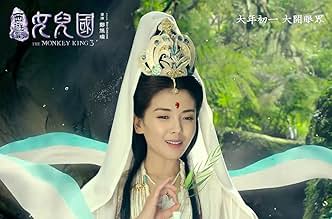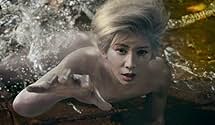Agrega una trama en tu idiomaA travelling monk and his followers find themselves trapped in a land inhabited by only women.A travelling monk and his followers find themselves trapped in a land inhabited by only women.A travelling monk and his followers find themselves trapped in a land inhabited by only women.
- Dirección
- Guionistas
- Elenco
- Premios
- 2 premios ganados y 4 nominaciones en total
- Dirección
- Guionistas
- Todo el elenco y el equipo
- Producción, taquilla y más en IMDbPro
Opiniones destacadas
Nothing special on this film and too much CGI using , this is when China got CGI ,China have a lot of location that very extraordinary but they choose to using CGI
"The Monkey King 3: Kingdom of Women," released in 2018, takes a distinct turn in the franchise, shifting its focus from predominantly action-driven sequences to a more character-centric narrative, with a strong emphasis on romance and interpersonal relationships. This installment delves into the "Women's Country" arc from "Journey to the West," providing a unique and somewhat controversial interpretation of the classic tale.
One of the most notable aspects of "The Monkey King 3" is its departure from the heavy reliance on large-scale action sequences that characterized the previous films. Instead, the film dedicates significant screen time to exploring the emotional dynamics between the characters, particularly Tang Sanzang and the Queen of the Women's Country. This shift in focus allows for a deeper exploration of themes such as love, desire, and the challenges of adhering to spiritual vows.
Aaron Kwok returns as Sun Wukong, providing a consistent and compelling portrayal of the character's mischievous yet loyal nature. Feng Shaofeng's Tang Sanzang is also central to the story, and the film dedicates much time to his internal conflict between his religious duties and his burgeoning feelings for the Queen. The Queen of the Women's Country, played by Zhao Liying, adds a new and interesting element to the story.
However, the film's emphasis on romance has drawn mixed reactions from audiences. While some appreciate the attempt to explore the characters' emotional depths, others find the romantic subplot to be forced and out of place within the context of the "Journey to the West" narrative. Critics also pointed out that the films handling of gender roles was at times clumsy.
Visually, "The Monkey King 3" maintains the franchise's high standards of special effects and production design. The depiction of the Women's Country and its inhabitants is visually stunning, with vibrant colors and intricate details. However, the decreased emphasis on action sequences may disappoint viewers who were expecting a more action-packed experience.
In essence, "The Monkey King 3" represents a significant departure from the previous installments, prioritizing character development and romance over action and spectacle. While this shift in focus may not appeal to all viewers, it offers a unique and interesting interpretation of the "Women's Country" arc. The film's impressive visuals and solid performances contribute to its overall entertainment value, even if its narrative choices are somewhat divisive.
One of the most notable aspects of "The Monkey King 3" is its departure from the heavy reliance on large-scale action sequences that characterized the previous films. Instead, the film dedicates significant screen time to exploring the emotional dynamics between the characters, particularly Tang Sanzang and the Queen of the Women's Country. This shift in focus allows for a deeper exploration of themes such as love, desire, and the challenges of adhering to spiritual vows.
Aaron Kwok returns as Sun Wukong, providing a consistent and compelling portrayal of the character's mischievous yet loyal nature. Feng Shaofeng's Tang Sanzang is also central to the story, and the film dedicates much time to his internal conflict between his religious duties and his burgeoning feelings for the Queen. The Queen of the Women's Country, played by Zhao Liying, adds a new and interesting element to the story.
However, the film's emphasis on romance has drawn mixed reactions from audiences. While some appreciate the attempt to explore the characters' emotional depths, others find the romantic subplot to be forced and out of place within the context of the "Journey to the West" narrative. Critics also pointed out that the films handling of gender roles was at times clumsy.
Visually, "The Monkey King 3" maintains the franchise's high standards of special effects and production design. The depiction of the Women's Country and its inhabitants is visually stunning, with vibrant colors and intricate details. However, the decreased emphasis on action sequences may disappoint viewers who were expecting a more action-packed experience.
In essence, "The Monkey King 3" represents a significant departure from the previous installments, prioritizing character development and romance over action and spectacle. While this shift in focus may not appeal to all viewers, it offers a unique and interesting interpretation of the "Women's Country" arc. The film's impressive visuals and solid performances contribute to its overall entertainment value, even if its narrative choices are somewhat divisive.
Cosmetics and effects rivaling, if not trumping, The Shape of Water, a star cast, precedence and notoriety for its previous installments, and a story adapted from a famous ancient Chinese novel deeply imbedded in Chinese national identity (as well as renditions throughout East Asia), were all foundational pieces to set this film in good standing. While depicting the Journey to The West may be nationalist in itself, I find it incredibly unfortunate that this film took opportunity to inject current political propaganda, particularly in favor of the implications of limited children policies. What more, I concur with Elizabeth Kerr that this film "felt like a missed opportunity" to depict its primarily female cast as active-not-reactive. This may be in part due to the source content of the relevant chapters of Journey to the West, yet license had been routinely taken throughout each film in the franchise and there is no good reason to miss the mark here given the nature of the setting and plot. Traditional gender normative are further enforced by the villainization of androgyny and an unfavorable transgender depiction, which was a notable change from the source material. There is also a villainization of Western convention seen through the cosmetic portrayals of our main female protagonist and (for lack of better word) antagonist using the film's contextually-current beauty standards of China and America ("current" for the latter being a bit loosely defined from an American context as it leans a bit more early 2000s, yet still made iconic by American icons such as Barbie with blue eyeshadow, pink lips and blush high on the cheekbones, unnaturally lined eyebrows, and thick winged eyeliner), respectively. This is highly unfortunate given the franchise's seeming success and popularity overseas. Forgiving this work as a result of its context, particularly in how domestic businesses are obligated to be to some extent puppeteer by Chinese official policy in order to exist, the film is enjoyable as a campy (wire effects and costumes like the Power Rangers but CGI like a chef's kiss) and interesting installment to the series that uniquely focuses on love as opposed to strictly fantasy martial arts. I am weary about the injection of propaganda in future installments, but I wait with baited breath nonetheless to give an anticipated 4th installment, rumored to be in the works since 2018 (which I hope the pandemic has not entirely derailed), a chance. I hold on to hope that we may take a step back and focus more on what was done right with the second movie which lacked in the third to bring into the fourth- particularly an equal strength and depth of character for all participants, regardless of sex or gender.
From a coarse comedy gradually transitions to a semi-finished film industrial product, which rely on dialogue of figures in the film to explain what is happening now. Based on this, all the disputes and criticism about adaptation and casting are could be ignored.
What's more, as the only actor that performing seriously in the film, it seems that Aaron Kwok is in a inopportune filming site, such as when the Monkey King, a mighty mythological figure in ancient times, discussing that whether the abortion is reasonable with other ordinary people...
I already can accept the second movie to differ from the first one. But, the third movie is even more differ. I don't know if it was intentional or not, but as a trilogy, your movies need to have a visual handsign to make them have red string to one another. These trilogy in another hand, feel disconnected.
As for this trilogy, the 2nd movie is better than the 3rd movie. This statement coming from someone who still think Donnie Yen's first installment as the best.
I don't understand what happened to the downgrade. Is it so hard for the director to make his production consistent?
I heard the 2nd movie had the same CGI studio of Lord of The Ring and The Hobbit to worked on the project. I think this movie couldn't get that studio back and it ended up in lesser quality.
The tonal shift of somber, but humorous 2nd film to this full on soap opera comedy blew my mind in the bad way.
As for this trilogy, the 2nd movie is better than the 3rd movie. This statement coming from someone who still think Donnie Yen's first installment as the best.
I don't understand what happened to the downgrade. Is it so hard for the director to make his production consistent?
I heard the 2nd movie had the same CGI studio of Lord of The Ring and The Hobbit to worked on the project. I think this movie couldn't get that studio back and it ended up in lesser quality.
The tonal shift of somber, but humorous 2nd film to this full on soap opera comedy blew my mind in the bad way.
¿Sabías que…?
- TriviaIt takes Aaron Kwok, Gigi Leung, and Him Law for about five to six hours to put on their special makeups; the makeups are easier for Shaofeng Feng and Shenyang Xiao, who only have to spend two to three hours. The heaviest make up goes to Chi-Ling Lin's character as the river goddess, for which she has to spend eight hours.
- Citas
National Division: Being a man is a capital crime. And being an ugly one... double guilty!
- ConexionesFollows El Rey Mono: El Inicio de la Leyenda (2014)
Selecciones populares
Inicia sesión para calificar y agrega a la lista de videos para obtener recomendaciones personalizadas
- How long is The Monkey King 3?Con tecnología de Alexa
Detalles
- Fecha de lanzamiento
- Países de origen
- Sitio oficial
- Idiomas
- También se conoce como
- The Monkey King 3
- Locaciones de filmación
- Taiwán(Studio and town)
- Productoras
- Ver más créditos de la compañía en IMDbPro
Taquilla
- Presupuesto
- USD 73,000,000 (estimado)
- Total en EE. UU. y Canadá
- USD 187,074
- Fin de semana de estreno en EE. UU. y Canadá
- USD 95,577
- 18 feb 2018
- Total a nivel mundial
- USD 115,084,576
- Tiempo de ejecución
- 1h 54min(114 min)
- Color
- Mezcla de sonido
- Relación de aspecto
- 1.85 : 1
Contribuir a esta página
Sugiere una edición o agrega el contenido que falta































